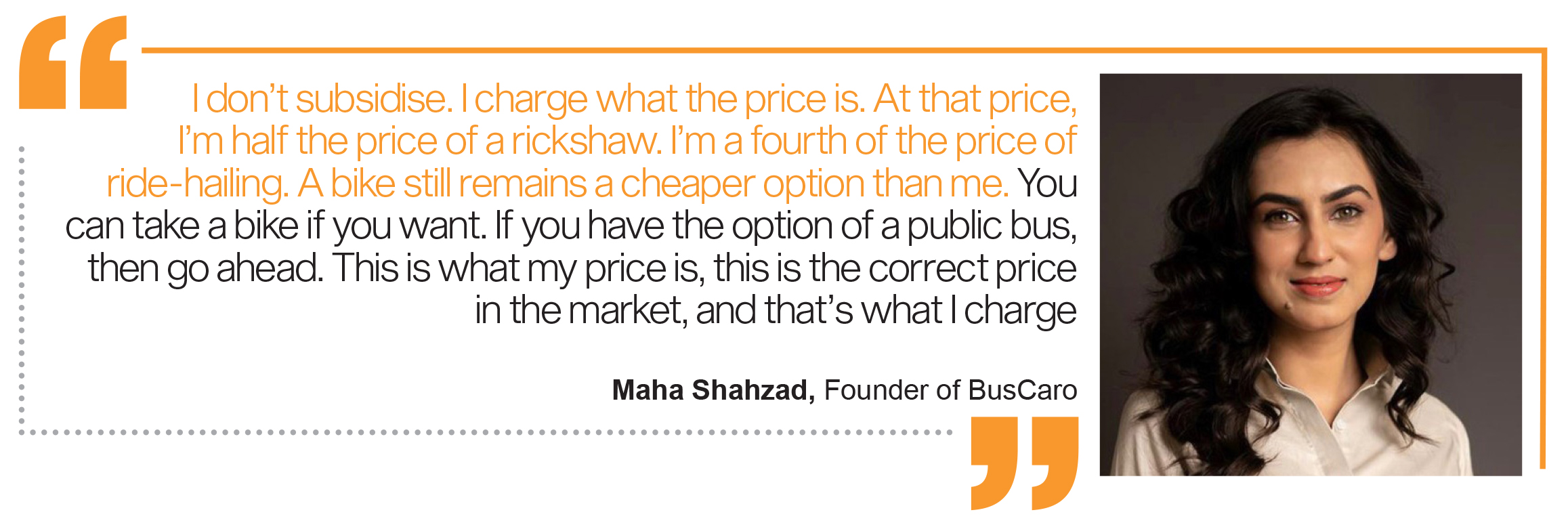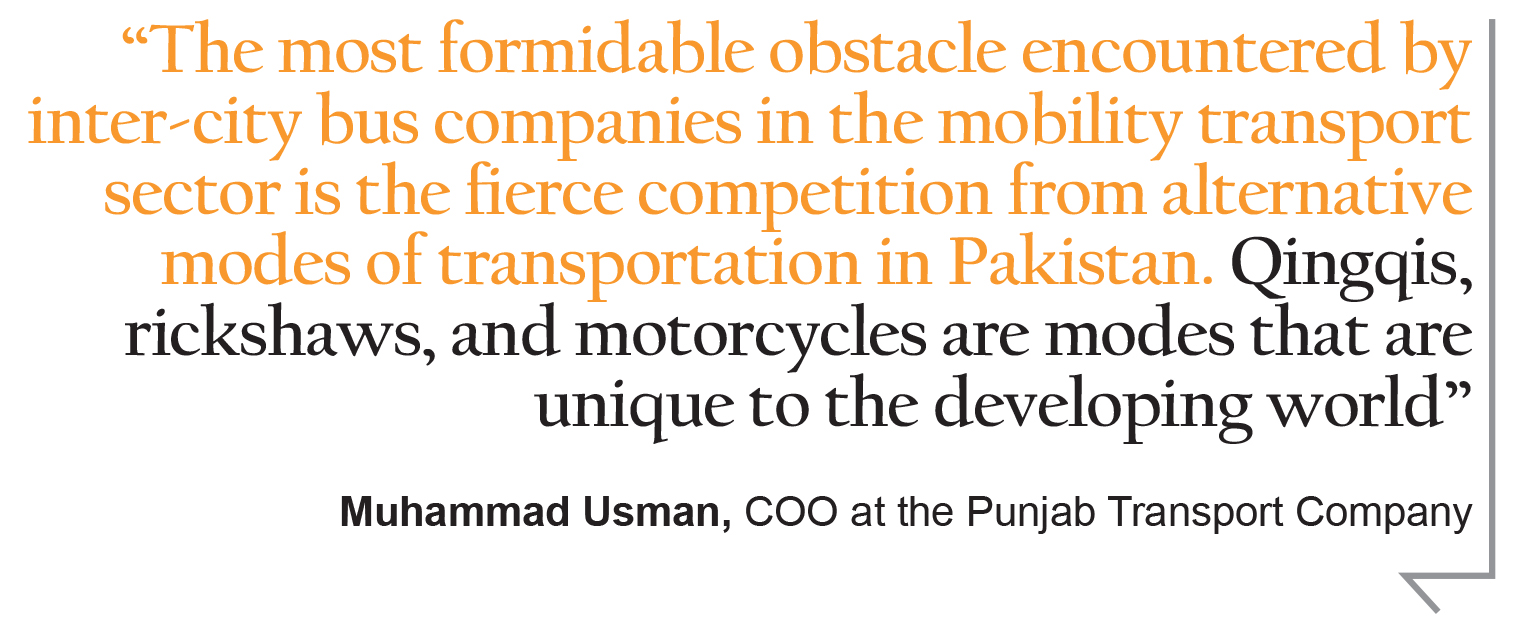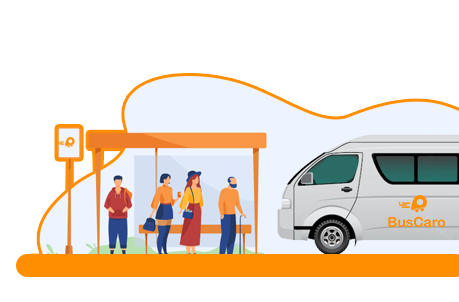If someone walked up to you today and said there was a new startup in town that was going to disrupt mass-transit with a low-cost, tech-heavy, bus sharing model what would you say? Unless you’ve been living under a rock since 2018, the immediate reaction for most would be a surprised exclamation of “again?”
Yet here we are again. BusCaro, a mass-transit solution startup, has recently entered the market that was left vacant by Airlift and Swvl at the beginning of the Covid-19 pandemic. At this point in the short history of Pakistan’s startup ecosystem both startups have become a cautionary tale in how not to spend VC money.
The names are thrown around anytime there is a conversation regarding aggressive growth, the importance of good business fundamentals or spending exorbitant amounts on customer acquisition. Which is why one would expect any new startup to stay away from an idea that has failed twice in the Pakistani market with a ten-foot pole.
Which means there must be something different that BusCaro is doing. So what is that something different exactly? And with funding already on the chopping block for Pakistan, how can BusCaro be a startup that says Bus Karo to burning venture capital?
The Airlift, and Swvl post-mortem
Any discussion of what BusCaro can, or cannot, do merits a trip down memory lane first. Albeit a thorny one, but we’ll be brief.
“The most formidable obstacle encountered by inter-city bus companies in the mobility transport sector is the fierce competition from alternative modes of transportation in Pakistan. Qingqis, rickshaws, and motorcycles are modes that are unique to the developing world, and are even more prevalent in Pakistan than in other developing countries,” elucidates Muhammad Usman Malik, Chief Operating Officer at the Punjab Transport Company.
“From the outset, Airlift and Swvl were embroiled in a struggle for survival against these modes,” he continues.

“In 2019, we surmised that the per-seat cost of a coaster operated by Airlift and Swvl was approximately Rs 250, while they were charging a mere Rs 20 per seat, Malik expounds. “They were confronted with the daunting challenge of attracting as many riders as possible whilst simultaneously striving to turn a profit. As their ridership swelled, so did their subsidies and revenue deficits. When they augmented their fares, passengers who had migrated from the aforementioned other modes of transportation reverted to their previous choices. Ultimately, the two had expended a considerable amount of money without achieving the volume of riders they desired,” Malik reflects.
So, what makes BusCaro any different to these two former titans?
Have any lessons been learnt?
As a user, it’s identical to Airlift and Swvl when it comes to booking a ride and getting on. In terms of the operating model, “We rent the buses at a certain price which comes with the bus and the driver. We pay a fixed amount for that and then we pay a variable amount for fuel depending on route and kilometres travelled,” explains Maha Shahzad, Founder of BusCaro.
If it’s like its predecessors for the customers, and it’s like its predecessors in terms of operations. How is it any different?
“We’re a contribution margin positive business. We are profitable on an EBITDA level today in two out of three cities, and those are just the facts,” Maha adds. This makes no sense. Particularly, because Swvl never became EBITDA positive in Pakistan. It did in some of the countries it operated in, but not in Pakistan. How is this possible then?
“I don’t subsidise. I charge what the price is,” states Shahzad. “At that price, I’m half the price of a rickshaw. I’m a fourth of the price of ride-hailing. A bike still remains a cheaper option than me. You can take a bike if you want. If you have the option of a public bus, then go ahead. This is what my price is, this is the correct price in the market, and that’s what I charge,” Shahzad expounds.
This is where we have BusCaro’s eureka moment. It’s just that we might need to perform some linguistic gymnastics to unearth said eureka moment.
Shedding the marketing
“I’m not competing with public buses. If somebody wants this particular service, like people choose to take a rickshaw despite there being public buses or people choose to take a car or people choose to use ride hailing or people choose to use bike hailing. Similarly, if people want to use bus hailing which is what I do then that’s a service that we’re prodiving,” Shahzad continues.

“I compete more with say InDrive, and Careem today than I do with a public bus in terms of customer profiles,” Shahzad elaborates. And therein lies everything.
BusCaro just has a different understanding of the word transit.
“They’re a mobility company, not necessarily a transit company,” states Faizaan Qayyum, Doctoral student at the University of Illinois Urbana-Champaign where he also teaches urban planning and development.
“The Metro Bus is transit. Is Uber public transit? Is InDrive public transit? If I was to take a rickshaw from one place to another on my own with no other passengers, would it be classified as mass transit? These are privatised modes of transportation that get people from one place to another. BusCaro scales up in terms of the passengers it can accommodate. These riders are, however, from a specific socio-economic group,” Qayyum adds.
Now that’s not bad at all. If anything it allows BusCaro to avoid the race to the bottom which the aforementioned Airlift and Swvl so happily partook in. This is important, because public transit has fundamentally different economics to any of these companies.
Avoiding the slippery slope of public transit economics
“Governments, worldwide, offer subsidised public transport. One cannot simply consider the direct benefits of public transport, or the cost incurred by the government. Public transport is measured in terms of the benefits that the economy as a whole accrues because of it,” asserts Malik. So, the competition is something that’s not designed to make a profit. And it is competition if you come at it. There are no two doubts about that.
“Public and private transport services compete with one another wherever both are available. It is only where one of the two is absent that they complement each other,” Malik adds.Whilst Malik’s statements may seem rudimentary now, this is exactly what Airlift and Swvl did. Why might they have done so?

“Opportunities and gaps also emerge when there are disruptions in the sector, such as when fuel prices skyrocket. That’s when the private sector intervenes to meet additional demand if the public sector is unable to do so. However, the discrepancy between the cost of operating public transport and the revenue it generates is not sustainable for private companies in the long term,” Qayyum expounds. There’s also the case of Swvl and Airlift having the money to burn in this endeavour.
“In the past, there was an abundance of capital flowing into Pakistan, and the emphasis was on growth for its own sake,” states Kalsoom Lakhani, Co-Founder and General Partner at i2i Ventures. “Airlift and Swvl emerged in this environment, which enabled them to raise substantial funds. However, when that funding dried up, it had a profound impact on those companies because they were unable to generate any unit economies. Airlift, at least, had the foresight to pivot away,” Lakhani adds.
Let’s catch up now. BusCaro has the marketing of Airlift, and Swvl. It has the same operational model as them. The target market, however, is different. So, what’s the play?
Is there even a market for BusCaro?
“The state cannot provide a route from my particular doorstep to my office. It cannot make an individualised route for me. It can never cater to individualised service provision irrespective of how efficient, transparent or effective a State is,” explains Qayyum.
“At the end of the day, you will have stops as part of any transit network that you create. Getting to the stop and going to my destination from the stop is what we call last-mile connectivity. The best of transit systems fail when it comes to last-mile connectivity, and this is where the private sector steps in,” he adds. So we have a reason for BusCaro to exist, but what about the customer base?
“Upper income groups are never going to shift to collectivised modes of transportation. They’re accustomed to their cars and they will stick to them. Lower income groups in contrast cannot afford collectivised modes of transportation such as these. In a situation where a Qingqi costs Rs 20, and another costs Rs 15, they will go for the latter. Their finances are that limited and they are that price sensitive,” explains Malik.

He adds that the ideal market for collectivised transport are middle-income groups. “Those that e.g. have motorcycles or their car usage is limited due to any factor,” explains Malik.
According to the Pakistan Social and Living Standards Measurement (2018-19) by the Pakistan Bureau of Statistics (PBS), a staggering 54% of Pakistani households possess motorcycles, while a mere 6% own cars.
Taking into account the potential overlap between these two groups, it can be inferred that approximately half of all Pakistani households lack any form of motor vehicle. This presents a lucrative opportunity for BusCaro, provided it maintains fair pricing and refrains from engaging in the cut-throat competition that has plagued its predecessors.
The same PBS survey sheds light on another intriguing fact: the average Pakistani household comprises 6.24 members, significantly reducing per capita vehicle ownership. Even within households that do own vehicles, particularly cars, access is often limited.
As Qayyum elucidates, “It’s not uncommon for car-owning families to possess just a single vehicle. Women in such households frequently have restricted access to cars and must rely on male family members to chauffeur them to their desired destination.”
But what about individuals who own a car and have unfettered access to it? Qayyum ponders the challenge of convenience: “Take the Mehran for example; it travels 17 km per litre. It’s affordable and offers protection from the scorching heat. You have the freedom to depart and return at your leisure and can even run errands en route. Why would anyone opt to pay more for a bus ride when they could simply drive their car? Why pay the same amount or even more when you have the luxury of your own vehicle?”
Nonetheless, there remains a possibility that customers who own cars and have ready access to them may choose to forego their personal vehicles. In such instances, they still have alternatives such as Careem and InDrive. What’s to say they don’t make a grab for the market?
The Careem, and InDrive equation
“There’s a venn diagram of users. BusCaro’s power users might not be someone that uses Careem and/or InDrive, and vice versa. I do think that at least for their early adopters, they’re not competing for the same kind of user,” states Lakhani
However, this does not imply that users will be bereft of choice when they reach for their phones. “Going just to the corner of the street in the sweltering heat of July and August is enough to sap an individual’s energy. Even if BusCaro were to collect its passengers from the corner of the street, their challenge will be to entice their passengers to walk there whilst alternatives exist,” Qayyum expounds.
“It ultimately boils down to what holds greater importance for the user, particularly in light of the current environment where the cost of living is escalating: “It’s a question of walking to a stop versus being chauffeured directly to your doorstep. It’s a balancing act between convenience and cost,” says Lakhani
My understanding is that for their current ridership price trumps convenience. Even though it’s undeniably hot and necessitates walking and all of that, such inconveniences diminish in significance when price sensitivity escalates. We witnessed with Swvl and Airlift how customers flocked to more affordable options. They operated at a time when the economy was better. Presently, everyone is considerably more price sensitive and I believe they’re capitalising on that space right now,”.
What would transpire if InDrive and Careem were to engage in a price war to protect or expand their market share? “Price wars result in discounts. We’ve witnessed this phenomenon in almost every sector that has become fiercely competitive. The B2B e-commerce space in Pakistan exemplifies this trend, where companies raced to the bottom in terms of discounts,” Lakhani elucidates.
“In the current environment, any high-burn play that necessitates raising substantial funds and is heavily discount-oriented would raise red flags for investors,” Lakhani muses
However, Qayyum believes that it might be feasible: “In the short run, investors can afford to do strange things,”.
Lakhani adds that “growth for growth’s sake was the norm because there was an influx of capital into Pakistan. Companies like Airlift and Swvl were able to raise significant amounts of money. But when that money dried up, particularly in the case of Swvl, it rocked those companies because they weren’t able to produce any positive unit economics,”.
“There is now a greater realisation among international investors that they must exercise greater prudence when conducting due diligence. There’s a focus on how they manage their investments, where governance is, and so forth. There is more importance on many of the considerations that were thrown to the wayside in 2021 and previously,”Lakhani continues.
Third times the charm?
So, we have a company that has all the features of two companies that succeeded in some capacity previously but with positive unit economics this time around. All good then? Perhaps. Is there anything that can go wrong? Lots. We’ve discussed quite a bit already.
However, is there anything that can particularly go wrong? Yes. What if BusCaro’s prudence is temporary?
Diamond hands or momentary prudence?
“Consider this: when a business flourishes in times of economic prosperity, capital is abundant. With investors eagerly pouring money into burgeoning enterprises, the expectation is one of hyper growth – a common occurrence during a boom,” states Shahzad.
“However, I find myself in the unenviable position of building during a recession. As such, I am subjected to scrutiny regarding unit economics and profitability, rather than being lauded for exponential growth,” Shahzad adds.
Lakhani laments: “In the current climate, it seems as though everyone is cowering with their tail between their legs. Retrospective conversations abound, with individuals bemoaning past actions and decisions. While I would like to believe that this will result in greater prudence and caution moving forward, experience has taught me otherwise.”
“I haven’t been an investor long enough, but history has shown that hype cycles tend to recur every few years. I see no reason why this trend should change in the future. Perhaps this warrants a broader discussion on the viability of venture capital as an all-or-nothing play?” muses Lakhani.
The question then becomes, is BusCaro going to change when the good times come? As it stands, it’s on the precipice of doing what Airlift, and Swvl could not. Albeit, at a significantly lower scale but in a profitable manner. Now, is this a temporary bout or something concrete? We’ll have to wait for the interest rates to truly put BusCaro to the test, because the only thing that ruins a good idea is the prospect of chasing a better one.










are you sure that BusCaro can burning their investor’s investment. is this Madam Maha Shahzad can Capable to run a this Business?
they are unofficially winding down as well. In Karachi, several of their routes have been discontinued. I can’t find a single ride towards the city. the writer should have at least tried to use their app to know they are not a business anymore.